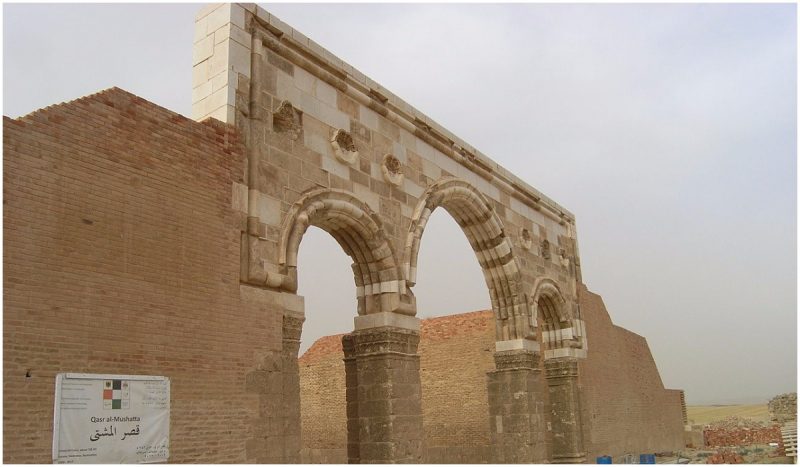Qasr Al-Mshatta, located near Amman, the capital of Jordan, is an excellent example of an Umayyad palace from the 8th century. It was used as a caliph’s residential palace and although partially in ruins, it still impresses. One quick look at these ancient ruins in the desert sands is enough to reveal their magnificence.
Only the central part of the entire complex has survived the centuries. But, unfortunately, the walls in the interior have long been completely empty, bearing no signs of the characteristic Islamic art. A great part of the breathtaking facade of the southern side of the exterior walls, including the main entrance with its richly detailed relief carvings, was deconstructed in the early 20th century and very carefully moved to Berlin’s Pergamon Museum, and can still be found in the permanent exhibition of Islamic Art.
Thus far, archaeological excavations show that the construction of the palace was started in 733 during the rule of Umayyad Caliph al-Wallid II ibn Yazid. But researchers still have not discovered its medieval name and now it is known as the winter palace (Qasr Mshatta). It is believed that the war with the Abbasid tribes and the tragic death of Wallid II in 744, who was killed by angry workers on the construction site of his palace, stopped the development of the complex. This is probably the main reason that the palace was never finished. At the end of the 8th century, parts of it were destroyed by a devastating earthquake, when most of the columns and watchtowers fell to pieces. Since then, the site has been completely abandoned.
Somehow, the forgotten desert palace was rediscovered in the 19th century. Actually, it first came to the attention of European scholars in 1840, when it was visited by the English diplomat and art historian Sir Austen Layard. Later, during the construction of the Baghdad and Hejaz railways, the site was noticed by the Germans who worked on the railway. They became enchanted by the beauty of this ancient miracle, and Ottoman Sultan Abdulhamid II gave parts of the precious facade to the German emperor Wilhelm II in 1903 as an act of friendship.
However, much of the carved facade has remained at the site and today this unique piece of early Islamic art can be enjoyed in its original location. In fact, the palace still attracts the attention of archaeologists and scientists, as well a great number of curious tourists. However, because it is located just next to the Queen Alia International Airport, it is being damaged by the air pollution.
The palace is the largest of all the Umayyad palaces in Jordan. Its formation is an audience hall, a small mosque, a throne room, and residences. The complex was encircled with a large defense wall about 472 feet long on each side, and many watchtowers. Sadly only a little of it survived. Just right of the entrance are the remains of the mosque. On the north side are the ruins of the arched audience hall and the residences. Broken columns are placed around the site literally in every direction. One peculiar characteristic of the palace, unusual for the buildings of that period in the region, is that the arches were built from burnt bricks instead of black basalt.
The themes pictured on the carved stones very clearly show the intention of the people of the early Muslim community to make a distinction between sacred and secular places. The facade’s walls on the secular and residential part of the palace are filled with peacocks, lions, griffins and other animals and mythical creatures, while on the wall that faces Mecca (also known as the qibla wall), which was a structural part of the mosque, no animals of any kind are depicted, but only images from the plant world, like pine cones, vines, and lotuses.
This evidence suggests that the Islamic practice of avoiding human and animal images on sacred spaces existed already in the 8th century. However, many archaeologists believe that the rich combinations of different art traditions are strong proof that both Persian and Egyptian artisans were involved in the construction of the palace. Qasr Al-Mshatta is a vibrant artifact standing as a testament to the timeless nature of art and beauty.
